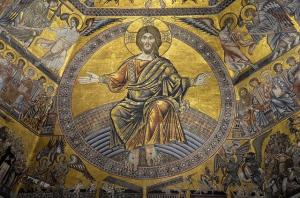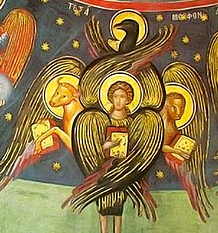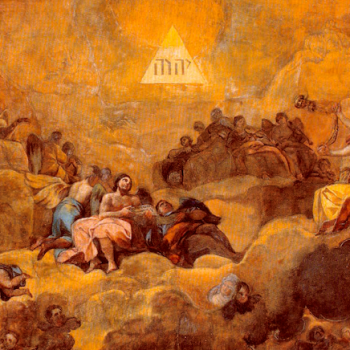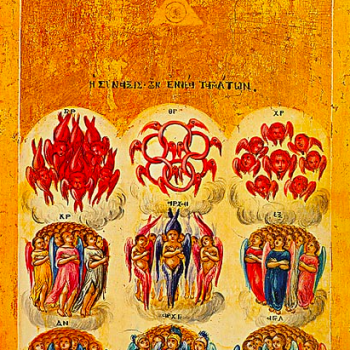Go here for a short intro to the rosary and for meditations on the Joyful, Luminous, and Sorrowful Mysteries.
The Mysteries
The Glorious Mysteries cover the events of Easter and its aftermath. They are as follows:
1. The Resurrection of Christ from the Dead
This covers the Resurrection itself and the forty days he then spent making further appearances to his disciples.
2. The Ascension of Christ into Heaven
This includes the Great Commission and the Ascension itself.
3. The Descent of the Paraclete on the Cenacle
This covers the Holy Ghost falling on the infant Church at Pentecost. (Paraclete is a name for the Holy Ghost, from a Greek word meaning “advocate, helper, counselor,” while cenacle refers to the Upper Room, where the disciples had continued to gather regularly after the Ascension.)
4. The Assumption of the Virgin into Heaven
This covers the Mother of God “falling asleep” (whether she actually died is not universally agreed upon by Catholics) and being taken into heaven bodily. This mystery is not explicitly attested in Scripture, and was defined as Catholic dogma only as recently as 1950.
5. The Crowning of the Virgin our Queen
This signifies the heavenly reception of the Mother of God as the Queen of the Church, the earth, and all creation. Here again, the mystery is not explicitly attested (or not in unambiguous terms—see Revelation 12 for a possible allusion); however, insofar as Christ is King, this would imply the queenship of his Mother, as in Near Eastern monarchies the reigning queen was normally the king’s mother, not one of his wives.

Literal Meditations
A bit unusually for me, I often use direct, non-symbolic texts for at least some of these (it’s a little harder with the last two, since they don’t appear explicitly in the Bible). Hence, my first series here doesn’t take much advantage of any of the allegorical senses of Scripture—they’re mostly quotes from the events themselves.
1. The Resurrection. John 20.19, Jesus came and stood in the midst, and saith unto them, “Peace be with you.” This specifically comes from Christ’s appearance to the Eleven (or rather, to ten of them, since St. Thomas was absent at the time) in the locked upper room on the evening of Easter Sunday. The word “peace” has often been highlighted as almost certainly a translation of the Hebrew shalom (or possibly its Aramaic equivalent shlama), a customary greeting whose many meanings do include “peace” but also range over ideas like “wholeness,” “safety,” “prosperity,” and “salvation.”
2. The Ascension. Matthew 28.20, Lo, I am with you alway, even unto the end of the world. Though Matthew does not record the Ascension, this text (the closing of the Great Commission) is generally associated with it. Interestingly, the word translated “world” here can have both a spatial sense and a temporal sense (as when we speak of “the ancient world”), and is often translated “age” elsewhere. For him to promise this just as he is leaving—I don’t think I fully get it, but it moves me. (I sometimes swap this meditation with the next one, as I feel both texts illuminate both mysteries.)
3. Pentecost. Acts 1.8, Ye shall be witnesses unto me both in Jerusalem, and in all Judæa, and in Samaria, and unto the uttermost part of the earth. This text of course comes from the Ascension proper, but the story of the Holy Ghost descending on the primitive Church and the miraculous tongues follows right on its heels, making the application obvious. (When I use it for the previous mystery, I sometimes mentally combine it with John 12.32, I if I be lifted up from the earth will draw all men unto me.)
4. The Assumption. Galatians 3.26, Jerusalem which is above is free, which is the mother of us all. Here we do get a little allegorical: the immediate context is about the relation of the Church to Israel. However, it comes after St. Paul has allegorized the explicitly historical text of Hagar and Sarah (interpreting them together with the two mountains of Sinai and Zion as antitypes1 of Israel and the Church respectively), so I feel a little more justified than usual in taking “Jerusalem” symbolically here. (I also—though this is pure speculation with nothing at all to back it—have to wonder whether St. Paul may have written Galatians after the Assumption, and have been deliberately punning here.)
5. The Crowning. Revelation 12.1, There appeared a great wonder in heaven, a woman clothed with the sun, and the moon under her feet, and upon her head a crown of twelve stars. Even when I was a Protestant, this figure seemed to me to be very obviously the Mother of God. Revelation is of course a figurative text, which confuses some people when we talk about allegorical interpretation; remember, however, that the literal sense of a text is its literary meaning, not necessarily a flat-flootedly “factual” meaning. A good analogy here is political cartoons: in that context, an elephant is the GOP according to the conventions of the medium. Likewise, the seven-eyed Lamb of Revelation is literally Christ, not in the sense that Jesus’ body is ovine and has seven eyes, but in the sense that the correct literary understanding of the seven-eyed Lamb is Jesus. Interpreting the “woman clothed with the sun” to be the Mother of God is, in this sense, a literal interpretation of the text.
Apocalyptic Meditations
I don’t quite know how to define the following meditations. I settled on calling them “apocalyptic” because the first two point the Christian toward spiritual realities that are mostly hidden in this life (apocalypse comes from a Greek word literally meaning “unveiling”), and last three all come from Revelation. In any case, they’re alternatives, and I feel like they highlight different aspects of the mysteries.

1. The Resurrection. Romans 6.4, We are buried with him by baptism into death: that like as Christ was raised up from death by the glory of the Father, even so we should also walk in newness of life. This is of course the tradition Catholic understanding of baptism. However, it only happens once, and for most of us that’s in infancy, so I think we reflect on it less than we might. This is the root of our life in Christ; the sacrament of Confession restores us precisely to the life of baptism, and the Eucharist feeds it.
2. The Ascension. Colossians 3.1, If then ye be risen with Christ, seek those things which are above, where Christ sitteth on the right hand of God. The Ascension is another mystery I think we tend to neglect, because it rarely feels applicable in daily life. The idea that, in Christ, we are now enthroned in heaven is a pretty trippy one, and I don’t claim to fully get it (or to get it at all, really). Something that you find often in the Fathers but rather rarely in modern Christian literature—Charles Williams, Madeleine L’Engle, and C. S. Lewis are exceptions—is the idea that the Christian life is a cosmic reality.
3. Pentecost. Revelation 7.3, Hurt not the earth, neither the sea, nor the trees, till we have sealed the servants of our God in their foreheads. I don’t know whether the author of Revelation2 intended to refer to the sacrament of Confirmation here, but between the symbolism of the seal and the fact that the twofold body of the elect (Jewish and Gentile) is described immediately after this, it seems like a natural interpretation to me. Again we have a feeling that these mysteries are cosmic, something woven into the “stuff” of the universe.
4. The Assumption. Revelation 11.19, The temple of God was opened in heaven, and there was seen in his temple the ark of his testament. There is a long tradition of understanding the Ark of the Covenant as, among other things, an antitype of the Virgin. A lot of the symbolism clearly lines up: the Ark is covered in pure gold, no man may touch it, angels hover over it, God descends upon it, a jar of manna is concealed within it; some commentators even draw parallels between II Samuel 6.1-15 and Luke 1.39-56.3 The fact that the Ark is thus suddenly revealed (after being lost for centuries—cf. II Maccabees 2.1-8) in God’s “heavenly temple” is taken by some as a coded allusion to the Assumption.
5. The Crowning. Revelation 20.9-10, “I will shew thee the bride, the Lamb’s wife”; and he shewed me that great city, the holy Jerusalem, having the glory of God. Here I draw a little on my interpretation of Galatians 3.26 from the last set. I understand the heavenly Jerusalem to be, among other things, the Mother of God. (That she is also “the wife of the Lamb” points to multiple interpretive layers for me; in fact, I think the primary allusion here is to the Church as a whole, but the Virgin is herself the pre-eminent member and emblem of the Church.) The fact that she “has the glory of God” also aligns with the text of the Fourth Commandment, “Honor thy father and thy mother.”
Footnotes
1An antitype (sometimes shortened to type, as in the phrase “a type of Christ”) is a person, place, or thing that is held to foreshadow a greater reality, its archetype.
2It was St. John, the same St. John who was an Apostle and the Beloved Disciple and wrote the Gospel and I John, die mad New Testament scholars.
3II Samuel 6 recounts the taking of the Ark of the Covenant to Jerusalem, including the episode of Uzzah touching the Ark and being struck dead; the passage from Luke recounts the Visitation, in which the sound of the Virgin’s voice prompts St. John the Baptist in his mother’s womb to show his first sign of life. King David’s cry of “How shall the ark of the Lord come to me?” is often compared with St. Elizabeth’s “Who am I, that the mother of my Lord should come to me?”, and the geographic setting of the two stories is roughly the same.












